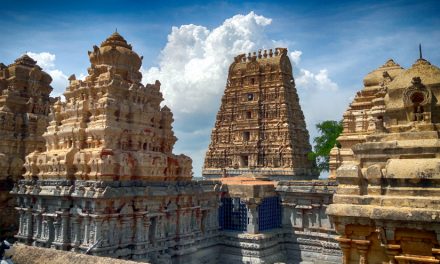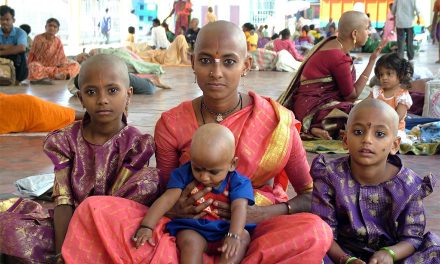In the East Godavari region, Vizianagaram district of Andhra Pradesh, is the village of Korukonda, an ancient and historical temple and Vaisnava divya kshetra that is home to Sri Laksmi Harasimha Swami. Korukonda is approximately 20 km. from Rajhmundry and 60 km. from Kakinada.
There are two temples here in Korukonda, one at the top of a large hill adjacent to the village, and the other at the foot of the hill, in the village proper. Pilgrims ascend a flight of 650 stone steps in order to have darshan of Sri Sri Laksmi-Narasimha Swami, the presiding Deity of Korukonda.
Temples are found all along the East Godavari River in this area, and there are several Narasimha Swamy temples, including the one at Dharmapuri and another at Antarvedi (tomorrow’s segment), where Lord Nrsimhadev is said to have thrown the body of Hiranyakasipu after slaying him. At Korukonda, the Lord is known as “Satvika Narasimha”, because He is accompanied here by His consort, Laksmi devi.
Of the two temples in Korukonda, one is swayambuvu (self-manifested) while the other houses the prathista (installed) Deity. The swayambhuvu is situated at the top of the long flight of steps.
The swayambuvu Deity Lord Narasimhadev which appears in a holy place near the top of this hill measures about 9 inches in height. The prathistaDeity is nearer the bottom and has much silpa soundaram around it. There are number of sila-sasanams which have appeared at the temple as well, on the top of the hill.
The temple was constructed about 700-800 years ago by the family of Parasara Bhattar, whose descendants continue to oversee the temple as trustees to this day.
In his poetry, the great sage Sri Srinatha prayed to Lord Narasimhadev, stating that this Korukonda is “Vedadri”. This belief is said to be supported by the sila-sasanam found at Lakshmaneswaram Village, Narsapur Taluk, W.G. District, which related to 1443 A.D.
An interesting inscription is found on one of the pillars in the temple compound. It states that the Vaisnava guru of King Mummadi-Nayaka of Korukonda left his mortal body and reappeared in the form of Narasimhadev on the top of the Parasara hill. A woman named Lakshmidasi of that town saw this in a dream and revealed it to Mummadi-Nayaka. With the permission of the Nayaka, she went about begging for money which she used to formally consecrate the image of Narasimha on the hill. King Mummadi-Nayaka made a gift of two villages and some lands and gardens to the temple. The inscription gives a genealogy of Mummadi-Nayaka and says that he ruled over the country on both sides of the Godavari in an area consisting of Panara, Kona, Kuravataka, and Chengara Districts, etc.
The Government have proposed new developments and improvements in the area around this temple, which is an increasingly popular destination for pilgrims. Nearby at the Jonnavalasa Railway gate there is also a Hare Krishna asrama.
Temple Worship and Festivals
Daily rituals at the Sri Laksmi Narasimha Swamy temple are performed according to Vaisnava Vyghanasa Agama Sastra. Regular festivals held at the temple include the following:
Sri Swamy Vari Kalyana Mahostavam (Phalguna Suddha Ekadasi) (March)
Telugu New Years Day (Chaitra Suddha Padyami) (March/April)
Sri Ramunjula vari Thiru Nakshtram (May)
Godavari Pushkara Mahostavam (Sravana Masam – Entrance of Guru in Simha Rasi) (July/August once in 12 Years)
Sri Vaisnava Krishnastami
Sarannavarathri Utsavam (Sri Lakshmi Poojalu) (Asveeja Suddha Padyami) (October)
Dhanurmasa Rituals (Margasira Masam) (December)
Mukkoti Mahostavam (Sudda Ekadasi) (January)












